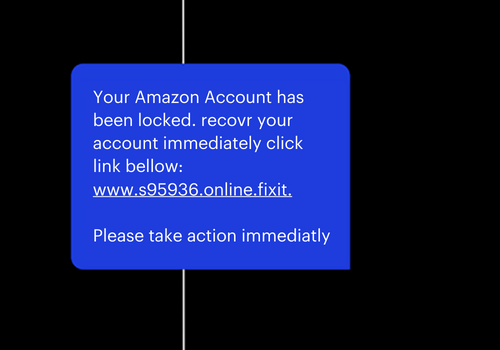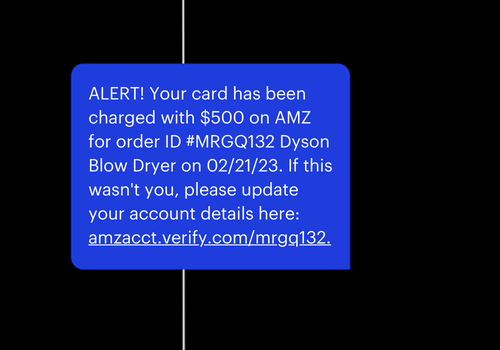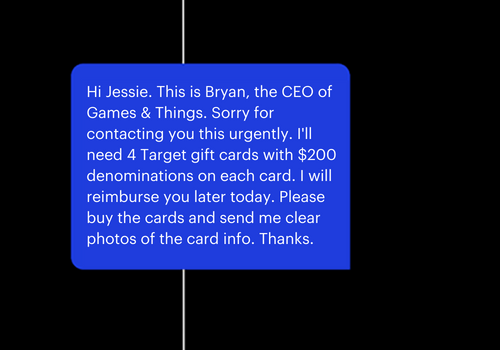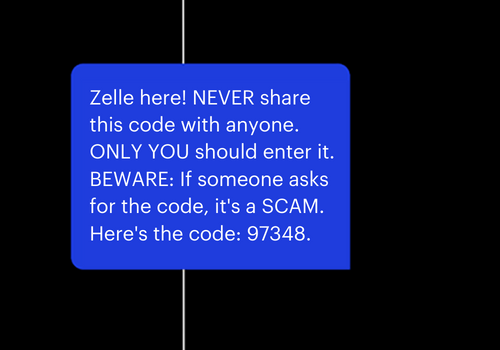How To Identify a Fake Text Message in 7 Easy Steps
Scammers don’t pick favorites: Whether you’re dealing with a personal mobile device or a business line, there’s a strong likelihood that you’ll eventually be the target of a spammy text message at some point. Fake texts are annoying and can be especially problematic if they go to a shared work phone and your employees aren’t familiar with fake texts and don’t know how to proceed.
There’s also another practical application of learning how to identify a fake text message. You can use the signs of a fraudulent texts as a guide of what not to do in your SMS campaign. Our SMS marketing guide can help with this as well.
With so many reasons to know how to identify scam text messages, all that’s left is to learn the most common signs of such messages and what to do about fake texts.
Manage customer conversations history in the same platform that gathers reviews, payments, feedback, and more.
Why Do I Get Spam Text Messages?
Spam messages are popular because they are sent in large quantities that scammers will profit from, even if only a small percentage of receivers fall for the scam. Scammers also know that the vast majority of people can receive text messages and don’t know how to identify fake text messages. They don’t mind sending thousands of texts to potentially active numbers in hopes of getting one successful scam in.
Some of the types of information that spammers may try to collect through text messages include:
- Personal details such as name, address, phone number, and social security number.
- Financial information such as credit card numbers, bank account numbers, and passwords.
- Login credentials for online accounts such as email or social media accounts.
- Personal health information such as medical history or insurance details.
- Geolocation data which can be used to track your movements.
- Other sensitive data that can be used in identity theft or fraud schemes.

Ready to grow?
See immediate impact with Podium’s suite of lead management and communication tools.
How to Identify a Fake Text Message: 8 Tips
The primary method of identifying fake text messages is to look for warning signs that you are dealing with a scam. The following are some of the most common indications that your unexpected message is fake.
1. The message is irrelevant to you.
If the message is completely irrelevant to you, there’s probably no legitimate reason you should receive it. In the best-case scenario, the message was intended for another person. In the worst-case scenario, it was spam. Either way, simply delete messages from unknown senders.
2. The text message contains misspellings or poor grammar.
If the text claims to be from a business or organization but has grammatical errors and misspellings, this is a major red flag. This may or may not indicate spam if the message claims to be from someone you know or contains a questionable link.

3. Abnormally long numbers.
As a business owner, you know that most legitimate phone numbers will be either ten digits long or a shortcode. If a number is longer than this, it is likely to be a scam. There are exceptions to this, such as international numbers, but you should strongly consider this a suspicious text message.
4. The message is from a bank or other financial institution.
Beware of abnormal-looking numbers that claim to be banks or financial institutions. When in doubt, don’t be afraid to call or visit your bank to confirm whether a text has come from them.
5. It offers random prizes.
One of the most common text scams is a text message telling you that you won a prize, but you need to complete a few steps first. If you didn’t join any contests recently, then chances are the text message is a scam. That is especially true if the prize seems too good to be true. The text message doesn’t even have to offer a prize. It can just be writing discount offers.
This is one of the takeaways to keep in mind as a local business owner. If you conduct a giveaway over text messages, go out of your way to make it seem as legitimate as possible. Savvy people will already be on alert unless they remember entering the giveaway.
6. The text message contains a suspicious link.
Another significant indication is if the text has a suspicious link. As a general rule, if unwanted text messages have a link and are not from someone you know, it’s likely to be spam.
7. The message’s tone is urgent or requests your immediate action.
Among the most common warning signs is when the message seems urgent and demands immediate action. Examples include:
- A family member or someone you know in crisis
- Claiming to be a government agency or the IRS
- Claiming to be your bank about your bank account
The sense of urgency is designed to have you respond so quickly that you forget to consider if the text message was legitimate.
8. The text offers a fake refund.
It’s also very common for scam text messages to say that you were accidentally overcharged in some way. This text message will often ask you to send back a code for a refund. The process that the scammer claims will give you a refund will typically actually send them money.

5 Fake Text Message Examples to Identify Spam
Wondering what common fake text messages look like? Here are a few examples.
1. Congratulations, You’ve Won!
Have you ever received a text message claiming you’re the winner of a contest you don’t remember entering? If it seems too good to be true, it probably is. You should never click on the links in these kinds of messages.

2. Verify or Update Your Account
Always beware of text messages asking you to verify or update account details. If the URL looks spammy, it probably is. Instead of clicking the link, head directly to your account to further investigate.

3. Assist an Acquaintance or Family Member
Got a weird message claiming to be from someone you know and asking you to buy gift cards? This is another common scam you should never fall for.

4. Two-Factor Authentication
Two factor authentication is a helpful security measure, but it can be pretty alarming when you get a code you didn’t ask for. If you get a text that looks something like the example below, there’s a good chance it’s fake—especially if you don’t have an account with the platform mentioned in the text.

5. Package Delivery
Notifications about packages you never ordered practically scream: scam! If you don’t remember ordering something and the text looks fishy, it’s best to ignore it. Here’s an example of this kind of spammy text message:

How to Report a Text Message Scam
The FTC offers clear guidance on what you should do about scam text messages. They highlight the fact that no company will ask you for account information via text.
If you do think that the request for information is legitimate, don’t respond via text. Instead, call the company in question using the phone number you have for them. This way, you will know you are contacting a legitimate company.
First, never open the link.
The FCT highlights that you should never click a link in an unexpected text message. You should follow this strategy even if you think you know the sender but aren’t positive.
Remember that clicking a link may download malware on your phone. That malware will gather information from your phone. It may also slow down your phone or even have your phone perform actions you didn’t intend it to.
If the link doesn’t install malware, it will likely take you to a questionable website. That website could be a phishing attempt to gain personal information, such as credit card information.
Do research before replying with STOP.
When you get a spam text, your first instinct may be to reply “STOP” in hopes that doing so unsubscribes you. However, you should always check the number and sender before doing so. That is because, in many cases, the scammers just want a response of any type. If you send them “STOP,” it won’t do anything except tell them that your line is active and it is a genuine phone number.
They may use that knowledge to their advantage to send you more spam text messages. They may also sell that information to others, meaning you may soon find yourself with even more spam messages.
Block the number.
If you’ve identified a spam text and want to avoid receiving future spam texts from that number, be sure to block the number immediately.
Report a bad message to your carrier.
Most carriers will let you report phishing and fake messages to them. You may even be able to block messages from that sender. For almost all carriers, you can report the spam by forwarding the message to 7726 (SPAM).
Other places to report a fake message.
You should also take a few seconds to label the fake text as spam. This is an option right in your native messaging app for many phones. It’s also smart to report the message to the Federal Trade Commission. You can do so by forwarding it to SPAM (7726) or reporting it via the FTC’s designated website for doing so.
Protect Your Business From Smishing
Tired of handling business on your personal cell phone? Getting a dedicated company phone number can help you personalize your customer texting and communications and reduce the risk of falling prey to spam attacks. Plus, having a dedicated business phone number makes it harder for spammers to impersonate your company.
Podium helps businesses simplify their customer communication, stay organized, and make the most out of business texts and calls. Interested in trying it out? Start a free trial today.
Fake Text Message FAQs
Can you get scammed by opening a text?
While the act of opening an unwanted text message is unlikely to be the scam itself, it is the first step. If you fall for a phishing attempt or click a suspicious link, yes, you can be scammed.
Can I trace text messages?
Your carrier can trace text messages, but they will typically only share the information with law enforcement. However, you can look up the number the message was sent from online or do a reverse search.
How do scammers have my personal information?
Scammers use a range of unscrupulous methods to get your personal information. You may be a victim of a phishing scam or data breach.
What happens if you reply to a fake text?
Replying to a fake text may have several different outcomes. You may receive additional fake messages or phishing attempts, your response could be monitored and used by malicious actors to gain information about you or your contacts. The sender may even gain access to sensitive information, depending on your response. As such, it’s always best to avoid responding to messages you suspect may be spam.
What does phishing mean?
Phishing is a type of cybercrime that involves the use of malicious emails, texts, or websites to trick individuals into providing personal information. Phishers attempt to appear legitimate by using official-looking logos, fonts, and language. Typically, phishing attempts are designed to steal confidential data such as usernames, passwords, credit card numbers, and other sensitive information.
Streamline your entire business.
See immediate impact with Podium’s suite of lead management and communication tools.
Keep reading
Get started today
Ready to grow? Scale your business with an AI-powered lead conversion platform.















